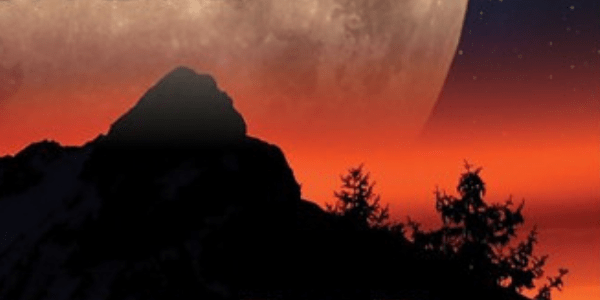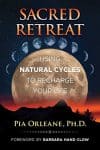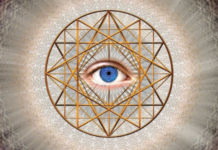Sacred Retreat: Using Natural Cycles to Recharge Your Life, by Pia Orleane, PhD
Bear & Company, 9781591437918, 246 pp., 2017
Pia Orelane, PhD, is an author and astrologer. A former practicing psychologist, she has co-authored several books with her husband, Cullen Baird Smith, based on the “wisdom from the stars from a group of Pleiadean Light Beings known as Laarkmaa.” Her website also states that she is a leading expert on the divine feminine and that shetravels the world lecturing on the topic.
When I first read the description of Sacred Retreat, I thought it would share techniques for connecting to the cycles of nature, and show how my natural rhythms fit into those cycles. The cover stated that it drew “on the wisdom of ancient cultures, and the natural cycles of life” and her own research to help “restore balance to our emotions and health, ease tensions between the sexes, and heal our fractured culture by divine feminine consciousness and re-embracing natural cycles, including our innate need for rest and retreat.”1 It was this emphasis on rest and retreat that I found most appealing. We live in a go-go-go, 24/7 world, and anything that could help me create time for rest or restoration sounded good to me.
The first clue that the book was not what I had hoped it would be was Barbara Hand Clow’s foreword, where she calls a person’s menstrual cycles and ability to birth babies as women’s “power base,” and that our separation from our monthly cycles has caused a distortion that “is so extreme that people are confused about their gender identity.”2 I am going to be honest — were I not tasked with writing a review of the book, at this point, I likely would have just set it down and walked away. However, it was only the foreword; I’d not yet read the author’s own words, so I pressed on.
The first couple of chapters of the book deal with our cultural disconnection from the cycles of nature and our own rhythms, the rise of patriarchy, and the resulting furtherance of this disconnect. I found a few things to agree with in these chapters.
In the first chapter, Orleane refers to the structure of the typical work day and how our adherence to the nine-to-five life interferes with our body’s natural tendency to set our sleep cycle by the natural light cycle. She also discusses natures cycles of sunrise and sunset, the progression through seasons, and how most of nature’s cycles allow for a time of dormancy and rest. A woman’s menstrual cycle is brought up several times and it is noted that our culture does not make room for the impact that our cycles can have on our lives. The chapter, “Biology and Healing,” covers the medicalization of the menstrual cycle, and the physical impacts that our 40-hour, all-work-and-no-play lifestyle has on our bodies.
A discussion follows of the change from “more spiritual” cultures to a religious and monotheistic one, and the contribution of this shift to our disconnection to ourselves and the natural world. However,
Orelane beings to veer into problematic territory, particularly when she makes multiple references to women being more naturally connected to nature because we have menstrual cycle, yet no reference to women who may not have a cycle or a uterus. She also makes such references to women taking the pill for “the sake of convenience,” as though taking the pill is nothing more than a way to make periods less troublesome, rather than the life-saving option many women choose so they can be the ones who decide when and if to have children.3
The remaining chapters cover a variety of topics including relationships, sexuality, creativity, dreams, and menopause. There are multiple references to women being the more intuitive gender, and that our wombs tie us more closely to the cycles of nature, again without reference to women without should do. The chapters on sexuality and romance seem to assume that all couples are heterosexual, while the chapter on menopause manages to not mention sexuality at all. Throughout the book, gender is nearly always referenced as a duality and always tied to biology. Transgender, intersex, and nonbinary people seem to have no place Orleane’s divine-feminine-awakened world.
In addition, some of the recommendations for how to become more in touch with our cycles, such as withdrawing from our daily lives and having a time of retreat during our time of menstruation, assume that all women are partnered, so there is someone else to take care of things while you take your time of retreat. Further, ti also assumes that we are all affluent enough to have living spaces that allow for us to have own bedrooms for sleeping alone during our menses, and to create a special space for each of us to retreat to. Other than the suggestion to make your meals ahead of time so you don’t needed prepare food during your period, it isn’t really clear how a single or less affluent woman might manage during this time.
In short, I truly wanted to like Sacred Retreat, but in the end, I found it to be a disappointing, gender-essentialist philosophy that defines men and women purely by their biology. She makes definitive claims that women are more spiritually inclined and naturally intuitive, simply because we have wombs, and that men are here to ground and balance our emotional nature. I agree that the degradation of the divine feminine and the rise of patriarchal culture has led us to a place of being on the edge of personal and cultural destruction. I also agree that part of our journey to restore balance to the world includes reconnecting to nature’s and our own natural cycles. But this needs to be done in a manner that embraces all people, not just those who conform to Orleane’s narrow and binary definition of gender.










